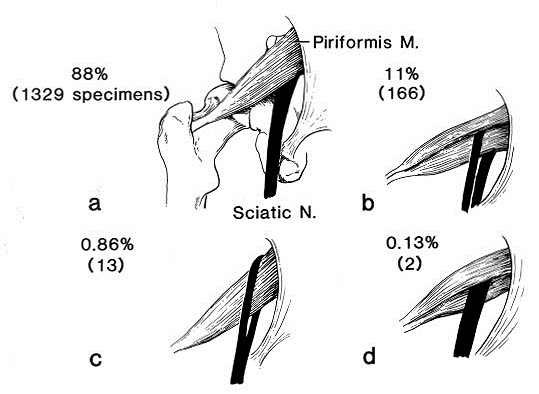FAIR test
Original Editors - Marlies Verbruggen
Top Contributors - Sheik Abdul Khadir, Marlies Verbruggen, Adam Vallely Farrell, Kim Jackson, WikiSysop, Vidya Acharya, Wanda van Niekerk, Melissa Decoen and Evan Thomas
Definition / Description[edit | edit source]
The FAIR test is a sensitive and specific test for detection if irritation of the sciatic nerve by the piriformis. FAIR stands for flexion, adduction and internal rotation. Also known as piriformis test. Piriformis Test Piriformis Syndrome
Clinically Relevant Anatomy[edit | edit source]
The piriformis is a flat muscle and the most superficial muscle of the deep gluteal muscles. It is part of the lateral rotators of the hip (obturator internus, superior and inferior gemelli, quadratus femoris, obturator externus, and gluteus maximus). It leaves the pelvis through the greater sciatic notch, until its fixation reaches the superior margin of the greater trochanter[1]. It has a piramidal shape that lies almost parallel with the posterior margin of the gluteus medius.[2]
The piriformis muscle can be used to locate the scietic nerve. This nerve enters the gluteal region inferiorly to the piriformis.If the lateral rotators of the hip are tight they may exert pressure on the sciatic nerve, producing pain radiating into the lower extremity[1][3].This is known as Piriformis Syndrome.
For more detailed information on the anatomy of the piriformis muscle.
Background[edit | edit source]
Number of extremities studied, 1510 [4]
A: Usual relationships with the sciatic nerve passing from the pelvis beneath m. piriformis.
B: M. piriformis divided into two parts with the peroneal division of the sciatic nerve passing between the two parts of piriformis.
C: The peroneal division of the sciatic nerve passes over m. piriformis and the tibial division passes beneath the undivided muscle.
D: In these cases, the entire nerve passes through the divided m. piriformis.
Technique[edit | edit source]
Position the patient in the side-lying with the tested hip on top. Passively move the patient's lower extremity into flexion (90 degrees), adduction, and internal rotation. The examiner stabilizes the hip and applies downward pressure to the knee to internally rotate and adduct the hip,[5] [6] thus placing the piriformis on a stretch that compresses the sciatic nerve. A positive test occurs when pain is produced in the sciatic/gluteal area. Due to the position of the test, pain may produced in the anterior thigh as well as a result of femoral acetabular impingement, so it is important to ask where they are feeling the pain.
Variation[edit | edit source]
The FAIR test can be performed with the patient supine or seated, knee and hip flexed, and hip medially rotated, while the patient resists examiner attempts to externally rotate and abduct the hip.
The FAIR test result is positive if sciatic symptoms are recreated. [7][8][9][10][11]
Evidence Based[edit | edit source]
The FAIR test correlates well with a working definition of piriformis syndrome, based on prolongation of the H-reflex with hip flexion, adduction, and internal rotation (FAIR) and is a better predictor of successful physical therapy and surgery than the working definition. The FAIR test, coupled with injection and physical therapy and/or surgery, appears to be effective means to diagnose and treat piriformis syndrome. [11]
Diagnostic accuracy has been reported as; Sensitivity: .88; Specificity: .83; +LR: 5.2; -LR: .14 [11]
("Piriformis syndrome: Diagnosis, treatment and outcome- a 10-year study," "Unilateral limitation of abduction of the hip: A valuable clinical sign for DDH?").[12]
References[edit | edit source]
- ↑ 1.0 1.1 Oatis, C. A., (2009). Kinesiology : the mechanics and pathomechanics of human movement (2nd ed). Baltimore : Lippincott Williams & Wilkins.
- ↑ Piriformis. (2017, June 6). Physiopedia, . Retrieved 09:52, December 15, 2017 from https://www.physio-pedia.com/index.php?title=Piriformis&oldid=174010.
- ↑ http://teachmeanatomy.info/lower-limb/muscles/gluteal-region/
- ↑ From Beaton, L.E. and B.J. Anson. The relation of the sciatic nerve and its subdivisions to the piriformis muscle. Anat. Rec. 70:1-5, 1938
- ↑ Kirschner JS, Foye PM, Cole JL. Piriformis syndrome, diagnosis and treatment. Muscle Nerve Jul 2009 ; 40(1) : 10-18
- ↑ Lori A, Boyajian- O’ Neill et al. Diagnosis and Management of Piriformis syndrome : an osteopathic approach. The journal of the American and osteopathic association Nov 2008; 108(11): 657-664.
- ↑ Pace JB, Nagle D. Piriformis syndrome. West J Med. 1976; 124: 435-439.
- ↑ Foster MR. Piriformis syndrome. Orthopedics. 2002; 25: 821-825
- ↑ Benzon HT, Katz JA, Benzon HA, Iqbal MS. Piriformis syndrome: anatomic considerations, a new injection technique and a review of the literature. Anesthesiology. 2003; 98: 1442-1448.
- ↑ Magee DJ. Orthopedic physical assessment. 3rd ed. Philadelphia. Pa: WB Saunders Co; 1997
- ↑ 11.0 11.1 11.2 Fishman LM, Dombi GW, Michaelsen C, Ringel S, Rozbruch J, Rosner B, et al. Piriformis syndrome: diagnosis, treatment and outcome- a 10 year study (review) Arch Phys Med Rehabil. 2002; 83: 295-301.
- ↑ Jari S, Paton RW, Srinivasan MS. "Unilateral limitation of abduction of the hip: A valuable clinical sign for DDH?" J Bone Joint Surg2002; 84-B: 104-107. Web. 08/25/2012.







